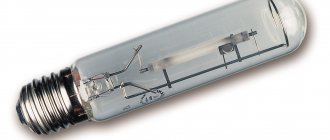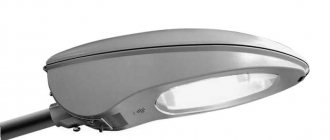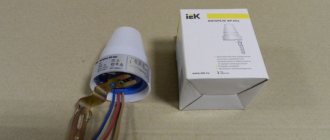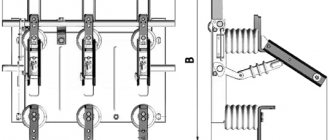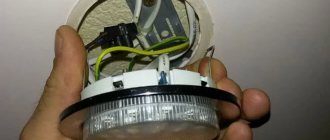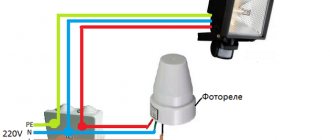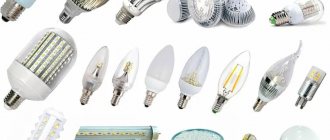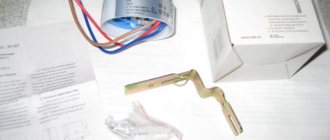Aug 15 • Articles • •
(
408 votes, average: 4.84 out of 5)
HPS lamps: a light source that was retired too early.
As we promised, an article about HPS (High Pressure Sodium Tubular Arc) lamps has finally arrived. Anyone who has worked or is working in the field of lighting technology knows firsthand about the HPS lamp. But if anyone doesn’t know, let’s explain it in simple terms: HPS lamps are like a Kalashnikov assault rifle for lighting streets and illuminating plants - a time-tested and reliable, but not without its shortcomings, light source.
Actually, this article about HPS lamps is more for beginners; material presented competently, but in an accessible language: without schematic diagrams of connection and a complete explanation of the basics of maintaining the discharge column in the burner of a HPS lamp. But we are sure that specialists will also like the sketch.
Actually, the subject: one of the invariations of the HPS lamp
Almost 100% of the world's roads (no one, of course, counted) until recently were illuminated by HPS lamps, until they began to be cut out of their supports in favor of LED lamps. However, even now, experienced designers prefer to stick a sodium lamp into the project out of harm’s way, because LEDs are 1. really more expensive, 2. not that much energy efficient and 3. still unpredictable, because The number of new LED manufacturers is simply off the charts. But more on that later.
Another option for a HPS lamp
HPS lamps come in different powers - from 50 to 1000 W (rarely, but they are found with a power of 2000 and 4000 W), which seems to hint at their “industrial” use rather than “household”. Basically, HPS lamps are used in luminaires for illuminating streets and roads, less often - in production in combination with white light sources (for example, with MGL lamps to achieve warmer light and greater energy efficiency). In the most perverted cases, they are put into production in their pure form. And then - before the first injury or the call “where to go.”
That rare case when HPS lamps are used in the wrong place
But the most indispensable application is lighting greenhouses, or supplementary lighting of plants (which, in fact, is the same thing, but the second is scientific).
Specifications
The main ones include luminous flux, luminous efficiency and operating time.
There is a direct relationship between the power of the element and the resource - high-power models last longer. Below are the technical characteristics of popular HPS sources with a power of 150, 250 and 400 W. All of them are connected to the lamp using an E40 type socket at a voltage of 120 V.
DNAT 150
Technical characteristics of the lamp DNaT 150
| Power, W | Flow, Lm | Light output, lm/W | Length, mm | Diameter, mm | Resource, h |
| 150 | 14 500 | 100 | 211 | 48 | 6 000 |
DNAT 250
Technical characteristics of the lamp DNaT 250
| Power, W | Flow, Lm | Light output, lm/W | Length, mm | Diameter, mm | Resource, h |
| 250 | 25 000 | 100 | 250 | 48 | 10 000 |
DNAT 400
Technical characteristics of the lamp DNaT 400
| Power, W | Flow, Lm | Light output, lm/W | Length, mm | Diameter, mm | Resource, h |
| 400 | 47 000 | 125 | 278 | 48 | 15 000 |
Designation of mercury lamps
Lamps are usually designated (according to ANSI, although many manufacturers do not follow these designations):
H33GL-400/DX
H - stands for mercury lamp
33 - indicates electrical characteristics. Lamps with the same number use the same ballast and are interchangeable. Accordingly, the ballast must be selected according to this number.
GL - refers to the shape and size of the lamp (but not the color), they come in different types.
400 - power. There are lamps of 50, 75, 100, 175, 250, 400 and more watts.
DX - color (DX - deluxe white)
DRL125 (10)
125 - power
10 - the number in parentheses (if indicated) is the “red ratio” as a percentage.
There are several types of phosphors for DRL lamps - L43, L50. Since the spectrum of mercury does not have wavelengths corresponding to red colors, rare earth elements are added to the phosphor, converting UV radiation into red colors, increasing the “red ratio”
| to the top of the page back to the table of contents |
Recommendations for selection
For specific use, lamps are selected according to the type of installation solution (column, floor lamp, string, wall). The problem of obtaining the required illumination (in lux) is solved by the power of the lamp, the type of reflector (reflective or white flat) or diffusing element. The color of the flow can be changed by the color temperature of the lamp or by selecting a filter in the lampshade.
It is also important that the style of the lamp matches the architecture of the house. Thus, a stylish minimalist lamp fits well into the facade of a modern building with a flat roof and rectangular architecture, while lamps reminiscent of antique gas lanterns are more suitable for a classically shaped house.
When choosing a lamp, one should not forget about economics: street lamps should consume the minimum possible amount of energy. Automation should help with this, switching the maximum flow rate to average, minimum and zero according to the selected program, photo relay or timer.
Design selection
The most popular types of street lighting are those that not only illuminate the area, but also make it more attractive. The most popular types of street lighting have become decorative lamps, floodlights and those equipped with solar panels.
The largest selection includes decorative lamps. Their wide variety makes it possible to realize almost all the ideas of designers and architects. At the same time, performers must remember that the moisture protection of external lamps must be at least IP44. Otherwise, devices installed in an open space must be under the roof (terrace, veranda, balcony).
Spotlights are equipped with halogen and high-power LED lamps, which differ from each other in service life and energy consumption level. Spotlights are also selected based on their scattering angle - the larger it is, the larger the illumination area. LED spotlights are often equipped with a motion sensor, which lights up the device only when a person appears in the capture zone.
When choosing street lighting, a group of solar-powered lamps is becoming increasingly important. They are produced mainly in the form of low posts pressed into the ground, but the number of options is growing. The latest samples give quite decent light at night after a daytime charge. There are also spotlights that operate in an energy-saving mode with a motion sensor.
Advantages and disadvantages
Sodium lamps are still actively used despite strong competition from LEDs. The reason for this is the following advantages of these devices:
- impressive service life;
- high light output;
- light spectrum comfortable for human vision;
- multifunctionality and versatility of application;
- high efficiency.
However, there are a number of disadvantages due to which HPS devices are inferior to competitors:
- difficulty of installation and connection for non-professionals;
- long warm-up time;
- strong heating of the tube;
- extraneous sound during operation;
- explosion hazard;
- presence of heavy metals.
Some types of sodium appliances are not environmentally friendly because the sodium amalgam used in them is a chemical compound of mercury and sodium. In addition, at low temperatures, the efficiency of HPS decreases.
Classification of street lamps depending on design
Methodology for calculating lighting in domestic and industrial premises
Street lamps are structurally different, which is caused by the installation features.
Street ground lamps are represented by three types of devices.
- Reflector lights: illuminate highways and major highways. The light flux from a 250-400 W lamp is focused and converted into a directional one.
- Lamps with diffused lighting: used for equipment on secondary highways. The lamp power is selected within the range of 70-250 W.
- Forged street lamps with diffused lighting: the lampshade can be cylindrical or spherical. Lamp power – 40-125 W. Pedestrian areas (paths, sidewalks, squares) are equipped with such lamps. A variety of them can be pendant street lamps. A lantern of complex shape may have a cantilever fastener.
In addition to ground-based ones, there are street lighting lamps of other designs.
- Facade lamps are most often spotlights. They are mounted on walls, installed on parapets and directly on the ground. The latter are used to equip stairs and garden paths.
- Street ceiling lamps are mounted above the porch of entrances, in the halls of open-type stations. Another option is outdoor recessed lights.
- A street lamp suspension can decorate the front porch.
- The built-in waterproof device is used to illuminate fountains.
When choosing an outdoor lighting lamp, it is necessary to take into account not only its main characteristics. The device must be organically combined with the architectural style of the building. And it is desirable that it be inexpensive.
Types of lighting fixtures
Sodium lamps are divided into two types: high and low pressure.
In plant growing, high-pressure sodium lamps are used for greenhouses. NLVD are divided into the following types:
- HPS are ordinary arc lamps with powerful light emission. One of them is quite enough to illuminate a small garden structure. The emission spectrum of such devices can be changed by combining them with other types.
- DNaZ – lighting sources with a mirror reflective layer. The layer is applied to the inner surface of the flask. It is effectively protected from adverse weather conditions and mechanical stress and increases productivity. Sintered electrodes are located inside the flask. They provide high efficiency and reduce energy consumption. Compared to HPS, mirror lamps are not powerful enough.
- DRI and DRIZ are the most advanced devices for greenhouses. Metal halide devices are resistant to current surges, they last a long time, they have the most optimal radiation spectrum necessary for seedling growth, and high efficiency. But they are not without some disadvantages, the most important of which is the cost, which is quite high for the average consumer. Plus, they require a special cartridge to use. This makes it difficult to replace failed lamps.
Operating principle
An arc discharge must be maintained inside the sodium lamp bulb. For generation, a pulsed ignition device (IZD) is used. During switching on, the pulse can reach a power of 2-5 kW.
Under the influence of voltage, a breakdown occurs with the formation of a discharge. It takes about ten minutes to warm up the burner and reach the rated power of the device. At this time, the brightness increases and normalizes.
How DNAT works
In modern elements you can find a built-in choke, which limits the arc current and guarantees a stable supply of energy without ripples and other undesirable moments.
The device of sodium lamps
Externally, these lamps are similar to DRL. The outer body is a cylindrical cylinder made of glass, but it can also be in the shape of an ellipse. It contains a “burner” - a tube inside which an arc discharge occurs. The electrodes are located at its ends. They are connected to the base. Sodium is not used in the manufacture of the “burner”, since its vapors have a rather strong effect on the glass body. In addition, the outer flask also plays the role of a “thermos” - it isolates the burner from the external environment.
The figure mentions a getter. It is rarely mentioned in reference documentation. A getter is a gas absorber, an adsorber. It is capable of capturing and retaining gas with the exception of inert ones. It finds its application not only in gas-discharge lamps, but also in radio electronics - electric vacuum devices. Its main function is to increase service life. The absence of foreign substances reduces “poisoning” of the electrodes.
The burner itself is made of polycor - polycrystalline aluminum oxide. It is obtained by sintering. Moreover, only the alpha form of the crystal lattice is acceptable for the manufacture of the discharge tube body. It is characterized by the maximum density of “atomic packing”. This is a development by General Electric. The developer called this material “lucalos”. It is resistant to sodium vapor and transmits about 90 percent of visible radiation. For example, dnat 400 has a tube 8 centimeters long and 7.5 millimeters in diameter. With increasing power, the size of the “burner” increases. The electrodes are made of molybdenum. In addition to sodium in vapor form, an inert gas, argon, was pumped in. It is required to facilitate discharge formation. To improve light output, mercury and xenon are introduced. When the lamp is operating, the temperature in the burner reaches 1200-1300 Kelvin. About 13,000 Celsius. To prevent damage, air is pumped out of the flask. The vacuum is quite difficult to maintain, since thermal expansion can cause microscopic cracks and holes to appear. Air can enter through them. To eliminate this, special gaskets are used. The flask does not heat up as hot as the burner. The usual temperature is 1000 C. The glow shows orange, yellow, and golden colors.
Previously, lamps had only a round threaded base, like household incandescent lamps. However, recently a new type of base has appeared - Double Ended.
Regardless of the design, the spectrum will be approximately the same.
This type of lamp is mainly used by agricultural enterprises. They are usually twice as thin as a standard sodium lamp. The flask is made of quartz. There is nitrogen inside the flask. The burner has two electrodes for supplying a pulse and subsequent supply voltage to maintain the discharge. The leads are located at the ends of the lamp; this is a more advanced solution that avoids thermal deformation of the bulb.
HPS lamps with two burners have also been developed.
The variety shown in the photo is usually used for greenhouse placement (for supplementary lighting purposes). The second burner is a metal halide lamp. In fact, this model is a hybrid of DNAT and MGL in a single package.
But there are also models that contain a pair of identical burners. They are located in a common cylinder and connected in parallel. This is done to alternately use each of the gas-discharge tubes. During operation, only one emits light. The one that lights up is the one where the conditions are more suitable. This solution reduces overall operating costs. Otherwise, the options with one or two tubes do not have any fundamental differences; the power and luminous flux parameters will be the same. The schematic diagrams do not change.
Mercury lamps with built-in ballast (Self-ballasted Mercury Lamps)
These lamps have a built-in ballast in the form of an incandescent lamp spiral. Therefore they do not require additional ballast.
Due to the presence of a spiral, these lamps have low light output (17-20 Lm/W). The color temperature of these lamps is CCT=3300-4000K and the light transmission coefficient CRI=40-50. Due to the presence of a spiral inside the lamp, it produces slightly more light in the red region of the spectrum than a regular mercury lamp.
This lamp is designated similarly to a mercury lamp, only the first letter is S; Russian-made lamps are designated DRV.
| to the top of the page back to the table of contents |
Scope of application of GL
Characterized by a wide range of applications:
- street lighting in urban and rural areas, in lanterns for illuminating parks, squares and pedestrian paths;
- lighting of public premises, shops, production facilities, offices, trading floors;
- as illumination for billboards and outdoor advertising;
- highly artistic lighting of stages and cinemas using special equipment;
- for vehicle lighting (neon);
- in the lighting of the house.
Spotlight: scope and types
For open spaces, for lighting:
- industrial areas;
- sports complexes and stadiums;
- quarries;
- facades of buildings and various structures;
- monuments;
- memorials;
- entertainment shows;
- livestock complexes.
There are:
- asymmetrical;
- symmetrical.
| View | Application area |
| For strobe | Pulsed gas-discharge lamps of the IFK-120 type are used in photo flashes. The stroboscopic effect is often used in nightclubs: dancers in a darkened room are illuminated by flashes, while they look frozen, and with each new flash their poses change |
| For street lighting | The GL light source for street lighting is the combustion of gaseous fuel, which contributes to the formation of an electrical discharge: methane, hydrogen, natural gas, propane, ethylene or other types of gas. A factor for using GLs for street lighting is their high efficiency (luminous efficiency - 85-150 lm/W). Often used for decorative street lighting, the service life reaches 3000-20000 hours |
| For plants | As a rule, general-purpose LLs, high-pressure mercury lamps, sodium GLs, and advanced metal halide lamps are used to illuminate a large winter garden. You can use one or more ceiling lights with fairly powerful (from 250 W) gas-discharge metal halide or sodium diodes |
Disadvantages and advantages of GRL
| Disadvantages of gas discharge lamps |
|
| Advantages |
|
| Advantages |
|
Main conclusions
HPS lamps are economical, durable light sources that have high luminous efficiency.
However, due to strong light pulsation and poor color rendering, they are not recommended for lighting residential or industrial premises. But HPS is successfully used outdoors, in greenhouses, sports complexes, etc.
To connect the device you need to purchase an IZU, inductor and capacitor.
These devices start the light bulb, stabilize the current, and remove the load from the wires.
When choosing a HPS, you need to clearly define its tasks, study the characteristics in order to select the most suitable lighting device.
High pressure sodium lamps are very popular among buyers. The fact itself is not surprising, since the lamps work reliably for 20-30 years. The equipment is installed when it is necessary to illuminate certain rooms or individual areas - corridors, greenhouses, entrance blocks, incubators, medical rooms.
Installation of induction lamps
Despite many differences in the immediate operating process, induction devices still belong to the segment of common gas-discharge lamps. The main feature of such lamps is the absence of electrodes. However, this difference is also conditional. The basis of the design is also a flask that contains plasma - it acts as a generator of light energy. In addition, induction lamps are complemented by a gas cylinder, which is located next to the magnetic coil. Such devices are called electrodeless for the reason that direct contact of the working element with the gaseous environment is not provided. Also, the absence of classic metal electrodes inside the cylinder increases the service life of the device. As practice shows, lamps of this type are not recycled until the phosphor resource is used up. This corresponds to approximately 100,000 operating hours of the device.
Safety and disposal issues
Risks in operating sodium lamps are associated with high pressure and temperature inside the burner. Even the surface of the flask heats up to 100 °C and can cause burns if handled carelessly. There is a possibility of the flask rupturing under the influence of hot gases escaping from the burner.
In order to protect against the consequences of destruction, lamps are made in which the lamps are located behind thick glass. Pay attention to the design of the street lighting lamp (Fig. 5).
Due to the presence of mercury in sodium lamps, special requirements apply to their disposal. Used equipment must not be disposed of in general waste bins. They must be sent to special enterprises for neutralization and processing.
How to make a sodium lamp lamp
Since it is advisable to use HPS products in the household, the use of such light bulbs is relevant for many. But for their operation you will need special lamps. Their cost is high, so it makes sense to build a lighting device with your own hands.
What will you need?
To complete the task you will need:
- a metal-coated plate, its dimensions should be 35x40 cm;
- aluminum sheet that will be used as a reflective element;
- set of self-tapping screws;
- hammer;
- metal scissors;
- pipe with a diameter of 15 cm.
User Anatoly King Crimson spoke in detail about the preparation for the manufacture of a lamp for a HPS light bulb, as well as the creation of such a device.
https://youtube.com/watch?v=mbmFqzkRe_I
Step-by-step instruction
DIY Assembly Guide:
A metal-coated plate is prepared. It should have a mirror surface on the working side, and also be elastic and rigid. If it is not available, it is possible to install a stainless steel plate; this material is used in chimneys. The reflective element is designed to focus the light energy of the device and direct the lighting flux to the desired location. To calculate the dimensions of a reflex device, you can use special computer software that allows you to accurately calculate the efficiency. The plate is bent manually. When carrying out this task, when the central part is bent, you can use a hammer. The rest of the sheet is bent using a previously prepared pipe. To level the surface, you must act carefully. But this can only be done with your hands. At the next stage, the cartridge with the sodium light source is fixed; it can be secured to the back wall. In this example, it is made from the side cover of the PC processor unit. It is recommended to make holes in advance for ventilation of the system. To make a lid, it must be cut out of metal; special scissors are used for this. The socket is fixed to the back surface of the lighting fixture using homemade pins, the diameter of which is 4 mm. These elements are made from hooks purchased in the store. It is desirable that their threaded part be elongated. This will allow you to make several studs. The reflective device is fixed on the rear wall using special aluminum rivets. Their diameter should be 3.2 mm. If you do everything correctly and securely fasten the elements, the structure will ultimately turn out rigid. Then the throttle element, as well as a high-voltage pulse device, is installed in the lighting device
It is important that these components are suitable in size for the lamp body. For more convenient placement, it is possible to remove the board from the case
But the power plug, as well as the switching device with the filter capacitor element, can be left. The throttle is being installed. This example uses a Galad 250W ballast choke element and is optimally suited to the hull width, height and length. A pulse charger is installed next to it. It should have a wiring diagram for the inductor and light bulb, and you need to follow it. At the next stage, wires must be brought out from the housing to the lighting device; their length should be 3 meters. To connect to the socket, only heat-resistant cables must be used. Their insulation should be made of fiberglass. Then the assembled lighting device is configured; this must be done before using it. The lamp is activated; this must be done in a dark room. You must wait until the sodium light source is completely heated. It is necessary to visually assess the quality of the lighting flux, which is reflected by the reflector device. If necessary, this element is bent, but this should be done before it gets hot.
The reflector adjustment procedure must be performed carefully so as not to catch the light source itself. Otherwise, not only the light bulb may be damaged, but it may also explode. To optimize the luminous flux, you can slightly bend the edges of the so-called parabola on the lamp.
User Dmitriy Rostkov spoke in detail about the creation of a reflective device for a HPS light bulb.
Safety precautions during operation
Due to the fact that the light bulb heats up to high temperatures during operation, you must be careful when using it:
- After turning off the light source, the bulb bulb should not be touched for 10-15 minutes.
- Do not touch the lighting device without gloves. Fingerprints can cause the light bulb to heat unevenly, and in some cases it may explode.
- When operating, the lighting source must be provided with good ventilation. It is advisable that the light bulb is not located near flammable structures. This also applies to the ballast throttle device, since it warms up to 150 degrees.
Connection diagram for neon lamps.
Gas-discharge light sources are connected to the power source through a resistor. It is inserted into the circuit to limit the current to 1 mA (or better, to tenths of a milliampere). Low current increases service life. Operating a gas discharge lamp without a resistor poses a threat to human health. The use of a resistor prevents the transition of the discharge to an arc, which can lead to a short circuit and explosion of the lamp tube. The design of some light sources immediately includes a resistor: it is mounted in the base. It is worth carefully studying this issue when purchasing.
Discharge lamps require high voltage. A household outlet does not do this. A step-up transformer is required. Its parameters depend on the dimensions of the lamps, their quantity, and the filling gas. The required voltage varies from 2000 V to 12000 V. For example, for lamps filled with neon there is the following dependence of voltage on length.
| Transmitter voltage, kV | Tube diameter, mm | ||||
| 8 | 10 | 12 | 15 | 20 | |
| 12 | 7000 | 8200 | 10000 | 12500 | 18000 |
| 10 | 6000 | 7000 | 8000 | 11000 | 15000 |
| 0,9 | 5500 | 6300 | 7500 | 9500 | 13500 |
| 0,8 | 4700 | 5400 | 6300 | 7400 | 11000 |
| 0,7 | 4100 | 4800 | 5800 | 7500 | 10500 |
| 0,6 | 3600 | 4000 | 4900 | 5800 | 8800 |
| 0,5 | 2900 | 3300 | 4000 | 5000 | 7300 |
| 0,4 | 2200 | 2500 | 3200 | 4000 | 5800 |
| 0,2 | 1000 | 1200 | 1500 | 2000 | 2500 |
| Transmitter voltage, kV | Tube diameter, mm | ||||
| 8 | 10 | 12 | 15 | 20 | |
| 12 | 7000 | 8200 | 10000 | 12500 | 18000 |
| 10 | 6000 | 7000 | 8000 | 11000 | 15000 |
| 0,9 | 5500 | 6300 | 7500 | 9500 | 13500 |
| 0,8 | 4700 | 5400 | 6300 | 7400 | 11000 |
| 0,7 | 4100 | 4800 | 5800 | 7500 | 10500 |
| 0,6 | 3600 | 4000 | 4900 | 5800 | 8800 |
| 0,5 | 2900 | 3300 | 4000 | 5000 | 7300 |
| 0,4 | 2200 | 2500 | 3200 | 4000 | 5800 |
| 0,2 | 1000 | 1200 | 1500 | 2000 | 2500 |
To supply such a high voltage, high-voltage wires are needed. Their insulation must withstand at least 1.5 hours of operating voltage. As an example, let's take the PMVK wire. It is inexpensive, can withstand up to 20 kV, and operates from -60 to +80 degrees.
There are two schemes for connecting lamps to a transformer. The first of them is standard. The lamps are connected in series to the transformer, and the transformer to a 220 V network.
Standard electrical diagram.
Zero point circuit.
The lamps are connected in two groups on opposite sides of the transformer. An equal number of light sources of the same type are used (in terms of size, gas filling).
The zero point circuit allows you to reduce the length of the wires. If one lamp breaks down, only one part of the circuit will stop working, and the second will continue to shine.
Due to its design, cold neon consumes less energy than regular neon. It can be powered from a low voltage power supply. To create the necessary electrical parameters (voltage, frequency), an inverter is built into the circuit. Depending on the model, inverters can be powered by twelve-volt power supplies or five-volt batteries. Up to three meters of neon can be connected to the batteries. And to the 12 Volt power supply - up to twenty meters.
Connection diagram to a power source via an inverter.
When installing, follow these simple rules:
- Wires and lamps should not come into contact with metal. If necessary, use polycarbonate holders.
- If two or more transformers are used, the wires from them are separated at a distance of more than 20 cm.
- The place where the wires pass through the metal is placed in a PVC pipe.
- All metal parts and the transformer must be grounded.
Principle of operation
An aluminum oxide burner is located inside the lamp body. It is filled with a mixture of gases (sodium amalgam, xenon). It is in this flask that the entire cycle of operation of the light source occurs.
HPS sodium lamps have a simple design, so their operating principle is also simple. As already mentioned, to function they need an IZU (ignition device) and electronic ballast (throttle). After turning on the lamp, the igniter generates voltage pulses into the lamp. Then an electron charge is formed in the sodium vapor in the form of an arc. The light source then emits yellow-orange light. However, immediately after starting, the lamp works weakly, since the burner needs time to warm up. After about 5 – 10 minutes the light becomes bright.
For uninterrupted operation of the HPS, an electronic ballast is needed. This device maintains a stable voltage.
Modern manufacturers produce DNAT, the design of which is slightly different. The new lamps already have a built-in igniter.
Scope of application
Since the color rendering of HPS is quite low, they are not used for lighting residential premises and workplaces. Most often, sodium light sources are used on the streets; they emit bright, contrasting light, increasing visibility on the roads even in fog and snow.
Areas of application of HPS lamps:
- Lighting systems for large areas, wide streets, highways, highways.
- Background lighting in tunnels, sports complexes, airports, railway stations.
- Illumination of monuments and other architectural structures.
- Lighting of workshops and warehouses where the level of color rendering is unimportant.
- Artificial lighting in plant nurseries, greenhouses, flower beds.
Lighting systems using sodium light sources demonstrate high-quality performance, weather resistance and high energy efficiency.
When choosing a lighting element, you need to clearly understand what function it will perform. After all, you need to choose a device with suitable power.
For greenhouses and conservatories, lamps from 70 to 400 W can be used. Ideally, a sodium lamp for plants should have a power of 150 - 250 W. Artificial lighting increases the growth rate and yield of vegetables, berries, flowers, etc.
With certain restrictions, 400W bulbs can be used for plants. In this case, the lighting equipment should be placed at a distance of 50 cm from the object. It is prohibited to use devices with higher power, as they will simply burn the plant.
Street lamps are usually equipped with HPS at 70 - 150 W. At the same time, for lighting devices it is necessary to select elements with the same power. For example, for 150W lamps a light bulb with the same value is suitable.
It is not recommended to install sodium lamps in home lamps, even with low power. They have a bad effect on the human visual system.
Connection features
If you don’t know how to connect DNAT, you can contact a specialist or try to figure it out yourself.
First of all, you need to prepare a kit, which includes the light bulb itself, an inductor, an IZU and preferably a capacitor. The connection diagram for a sodium lamp is usually shown on the body of the ballast or igniter.
To connect the light bulb, use a two- or three-pin igniter. The photo above shows a diagram of connecting a HPS lamp with an IZU, which has 3 outputs.
The picture above shows how to connect a HPS lamp using a two-terminal igniter with a capacitor.
The included capacitor device reduces the load on the wiring. That is, the cables will heat up less.
The DNAT is connected to a three-pin IZU according to the following plan:
- First, use a multimeter to check the insulation of the ballast and capacitor. Before dialing, the device must be switched to maximum resistance. This is necessary to check whether current is passing through the housing.
- The kit is assembled in a compact two-phase panel. For a 400W light bulb, a 5A automatic machine is suitable. It allows you to turn the lamp on/off and protects parts from damage.
- Remove 2 wires with a negative charge from the shield: connect one to the lamp, and the second to the “N” terminal on the IZU. The ballast is installed in the gap of the phase, and not the neutral core, which goes to the lamp.
- Disconnect the phase cable. Insert one core from the machine into the incoming contact of the ballast. And connect the cable from the output contact to terminal “B” on the ignition device.
- Route the middle wire “LP” from the IZU to the light bulb socket.
After connecting, you can check the bulbs for functionality.
If you have an ignition device with 2 terminals, then connect them in parallel with the HPS. To do this, after the choke, insert a phase conductor into the IZU, and connect a neutral conductor to the second terminal. It can even be pulled from the cartridge.
Two-pin ignition devices are not recommended for use with high-power HPS, since during startup the voltage is applied not only to the bulb, but also to the ballast. This can damage the inductor insulation. IZU is safe when connecting low-power light sources, which require no more than 2 kilovolts to start.
The capacitor device is connected in parallel to the entire circuit. To do this, one wire is connected to the phase output of the machine, and the second to the zero one. Then stretch the wire and disconnect it on the socket.
There are several types of gas discharge lamps:
Mercury: their light appears as a result of electrical discharges in mercury vapor with which the flask is filled. It is characterized by strong heating of the flask and surfaces that are nearby, which requires the use of heat-resistant materials. Mercury lamps (HLVs) are used in rooms with large square footage. Sodium (DNAT): work like mercury, but the flask is filled with sodium vapor. Protected from environmental influences by special glass. This safety measure is necessary, since sodium lamps are unstable to temperature changes and humidity. Metal halides (MHA): halides are added to the mercury vapor in the flask. They have high power (up to 2 kW), which is considered a guarantee of good room illumination
This is important for equipping large areas and sports facilities. Xenon: consist of tungsten electrodes, between which an electric discharge passes. The flask contains an inert gas and metal salts (mercury or sodium). Fluorescent: energy efficient lamps with a long service life
The big disadvantage is the use of mercury vapor that fills the flask. If the flask is damaged, the poisonous gas will become dangerous to human health. If luminescent devices are turned on and off very often, their service life is noticeably reduced. This characteristic does not prevent the use of these lamps for illuminating city streets. Induction: street lighting comes from ionized gas, which creates a plasma glow. The lighting is controlled using an inductance coil that generates a magnetic field.
LED floodlights for street lighting should be placed in a separate group. This light source is gradually being replaced by the ones listed above.
The outdoor LED lamp has the following characteristics:
- high efficiency;
- long service life (100 thousand hours or more);
- efficiency: electricity is not wasted on heating nearby objects. Serves to create a luminous flux
- resistant to various climate changes
- durable and not afraid of moisture
Advantages and disadvantages
If you can’t decide whether to buy HPS or LED lamps, then you need to consider the pros and cons of sodium devices. Then you can weigh the pros and cons to make the right choice.
The positive properties of sodium light sources include their high luminous efficiency, long service life, and low energy consumption. In addition, they have a high efficiency and are resistant to temperature changes.
However, HPS requires time to start (5 - 10 minutes), they have poor color rendering and distort colors, which cannot be said about LEDs. The disadvantages of the lighting element include frequent flickering of the lamp, which leads to eye fatigue.
HPS lamp design
Structurally, the light source includes the following elements:
- 1 - plug made of ceramic;
- 2 - ceramic tube designed to transmit light flux;
- 3 - outer flask made of refractory glass;
- 4 - electrode element of the light bulb;
- 5 — niobium rod;
- 6 - gas absorption element called barium rod;
- 7 - lamp base.
Schematic structure of a sodium lamp
Description of the labeling of DNAT type lighting sources:
- D - arc;
- Na - sodium;
- T - tubular.
Types of lamps
It should be noted that light bulbs can be separated from each other depending on the design:
- The light source can be manufactured in a transparent cylindrical outer bulb with a threaded base element.
- The device body can be made in the form of an ellipsoid. It will be matte or completely transparent. The light bulb is equipped with a threaded base.
- The flask itself can be cylindrical, made of quartz or glass. The lamp pinout will be double-sided.
- The device body can be manufactured in a special flask. The light bulb is equipped with an internal reflective element.
Designation of MH lamps
Russian-made lamps (lamps with a power greater than 400W are not shown):
| Lamp type | Lamp voltage | Operating current | Starting current | Light flow | Life time | Base type |
| Lamps with additives of sodium, indium and thallium iodides | ||||||
| DRI-75(3) | 1.2A | 5.5KLm | R7s | |||
| DRI-125(3) | 1.3A | 8.3KLm | R7s | |||
| DRI-150(3) | 1.4A | 11KLm | R7s | |||
| DRI-175(3) | 1.5A | 12KLm | E27/27 | |||
| DRI-250(1) | 2.15A | 4.3A | 19KLm | 3000 hours | E40/45 | |
| DRI-400(1) | 130 +10 - 15V | 3.4A | 7.15A | 34KLm | 6000 hours | E40/45 |
| Lamps with sodium and scandium iodides added | ||||||
| DRI-250-5(1) | 130±13V | 2.15A | 3.6A | 19KLm | 10000 hours | E40/45 |
| DRI-250-6(2) | 130±13V | 2.15A | 3.6A | 19KLm | 3000 hours | E40/45 |
| DRI-400-5(1) | 130±13V | 3.3A | 5.6A | 36KLm | 10000 hours | E40/45 |
| DRI-400-6(2) | 130±13V | 3.3A | 5.6A | 36Klm | 3000 hours | E40/45 |
(1) — The lamps have a transparent ellipsoidal bulb, the working position is any.
(2) — The lamps have a transparent cylindrical bulb, the working position is horizontal, with a deviation of no more than ±60 degrees
(3) — The lamps have a transparent cylindrical bulb, the working position is any
Correspondence of lamps from different companies (lamps made in Europe may have different designations):
| OSRAM SYLVANIA | G.E. | PHILIPS LIGHTING |
| Designer Series Metalarc Pro-Tech | Constant Color CMH | MasterColor |
| Metalarc | Multi-Vapor | Metal Halide |
| Metalarc Pro-tech | MPR | |
| Super Metalarc | High Output Multi-Vapor | Metal Halide |
| Metalarc Safeline | Saf-T-Guard Multi-Vapor | Safety Lifeguard Metal Halide |
| Briteline | MQI | MHN-TD |
| HQI | MQI | MHN-TD |
| Sodium lamps (High Pressure Sodium) | ||
| Lumalux Plus/Eco | Ceramalux Alto | |
| Lumalux | Lucalux | Ceramalux |
| Lumalux Standby | Standy Lucalux | Instant Restrike Ceramalux |
| Unalux | EZ Lux | Econolux |
| to the top of the page back to the table of contents |


